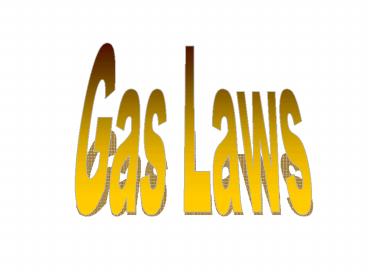Gas Laws PowerPoint PPT Presentation
1 / 24
Title: Gas Laws
1
Gas Laws
2
Properties
- Gases take the shape and volume of their
container - Weak intermolecular forces
- Volume is dependent on temperature and pressure
- Increase temperature, volume increases
- Increase pressure, volume decreases
3
STP
- STP Standard Temperature and Pressure
- Standard pressure
- 1 atm 101.3kPa 760 torr 760 mmHg
- Standard temperature 0oC 273K
4
Unit Conversions
- Convert the following
- 1.5 atm ______ kPa
- 3.2 atm ______ torr
- 250 kPa _____ atm
- 350K ______ oC
5
Kinetic Molecular Theory (KMT)
- For an ideal gas, all particles
- Are in random, constant, straight-line motion
- Have no attractive forces between them
- Collisions are perfectly elastic. When
collisions between gas particles occur there is
only a transfer of energy, not a loss of energy - No volume gas particles are separated by
relatively large distances - See Molecular Motion
6
Ideal Gases
- Real gases are not perfectly ideal because they
do attract each other, and occupy volume - Gases behave most like an ideal gas at high
temperatures, low pressure, and small masses
(this is when they agree most with the KMT)
7
Ideal Gas Examples
- 1. Which gas will behave most ideal at STP?
- a. Ar
- b. Ne
- c. N2
- d. O2
- Under which conditions will hydrogen behave most
ideal? - a. 20oC and 1 atm
- b. 20oC and 0.5atm
- c. 50oC and 1 atm
- d. 50oC and 0.5atm
8
Kinetic Theory of Gases
- At a high temperature they have a high velocity
(speed) - At a low temperature they have a low velocity
(speed)
9
Combined Gas Laws
- Temperature, Volume, Pressure are changing
- Temperature must be in Kelvin (K)
- P1V1 P2V2
- T1 T2
10
Examples
- 1. A sample of gas has a volume of 260mL,
temperature is 85oC, and pressure is 0.85atm. If
the temperature changes to 25oC and the volume
changes to 240mL, what is the new pressure?
11
Examples
- 2. An ideal gas has a volume of 1200mL a
temperature of 25oC and a pressure of 85kPa . The
sample is changed to STP. What is the new
volume?
12
Boyles Law
- Relationship between pressure and volume
- Temperature is constant
- Leave temperature out of the equation (since it
is constant) - Volume varies inversely with pressure (an inverse
relationship) - P1V1 P2V2
- Boyles Law Movie Clip
13
(No Transcript)
14
Boyles Law Examples
- 1. A 500.mL sample of gas at 120kPa is
compressed to 100.mL. What is the new pressure?
- If 40.0mL of a gas is stored at standard
pressure, what is the new volume if the pressure
is increased to 1.25atm? - A gas sample occupies 10.0mL at 1.0 atm. If the
volume changes to 20.0mL, what is the new
pressure?
15
Charles Law
- Relationship between temperature and volume
- Pressure is constant
- Leave pressure out of the equation (since it is
constant) - Volume is directly proportional to temperature
(direct relationship)
16
Charles Law
- Temperature must be in Kelvin (K)
17
(No Transcript)
18
Charles Law Examples
- The volume of a gas at 298K is 40.0mL. The
volume is decreased to 35.0mL, what is the new
temperature? - The volume of a gas is 50.0mL at 27oC. The
temperature is raised to 127oC, what is the new
volume? - At 30.oC the volume of a gas is 200.mL. The
temperature is raised by 15oC, what is the new
volume?
19
Partial Pressure
- The sum of the pressure exerted by each of the
gases in a gas mixture is equal to the total
pressure of all the gases - Total Pressure sum of the parts
- PT P1 P2 P3
- All of the pressures must have the same units
20
Partial Pressure Examples
- There are 4 gases present in a mixture. The
total pressure is 800.mmHg. The pressure of the
first 3 gases is 200.mmHg, 250.mmHg, and
250.mmHg. What is the pressure of the 4th gas? - A sealed flask contains a mixture of 3.0 moles of
N2(g), 1.0 mole of O2(g), and 2.0 moles of CO2(g)
at 25oC. If the total pressure of this mixture
is 12atm, find the partial pressure of each of
the 3 gases.
21
Grahams Law of Diffusion
- Gases diffuse at different rates depending on
their velocity (velocity is dependant on mass) - Lighter gases will have a higher velocity and
therefore will diffuse faster than heavier gases
22
Examples
- 1. Which of the following gases would diffuse
the fastest H2, O2, N2, Cl2, Ne? - 2. Which of the following gases would diffuse
the slowest H2, O2, N2, Cl2, Ne?
23
Avogadro's Hypothesis
- Under the same conditions of temperature and
pressure, equal volumes of all gases contain the
same number of particles - 1 mole 6.02 x 1023 particles
- 1 mole 22.4L at STP
24
Density and Molecular Mass
- Density molecular mass
- 22.4L/mole
- Examples
- The density of a gas is 1.96g/L at STP.
- What is the molecular mass?
- 2. Calculate the density of NO2(g).

